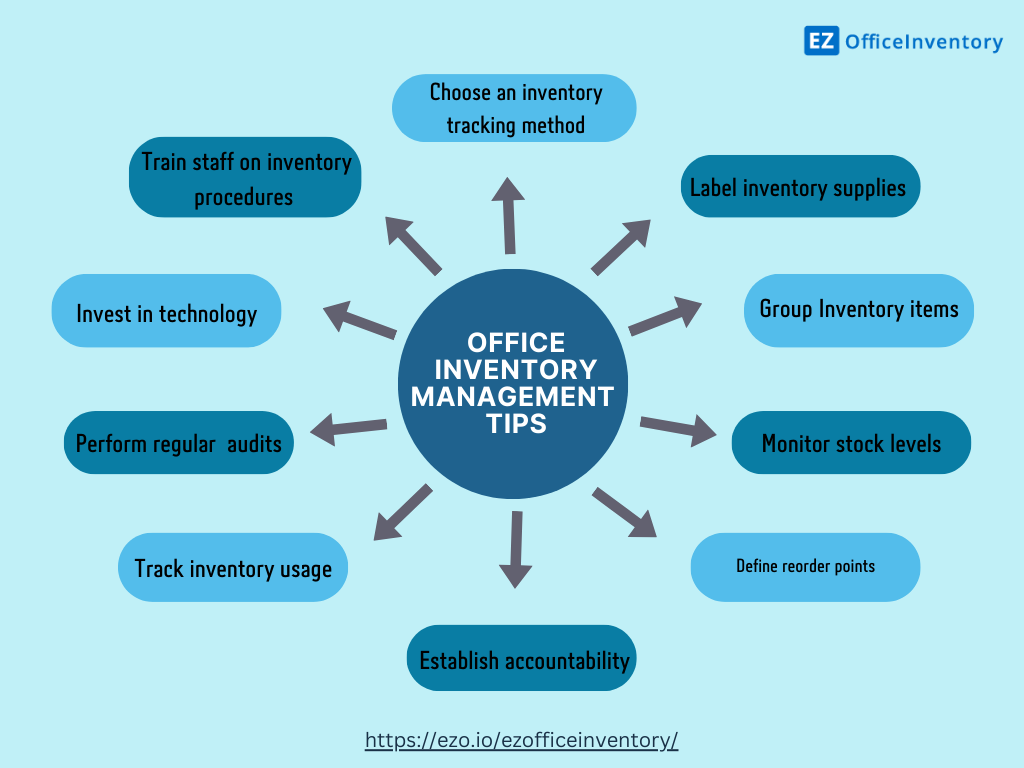Running an office has several aspects to it – from operational activities to decision-making. However, activities cannot continue or may be hampered if the office is not equipped with adequate supplies, making inventory management an important aspect of business success.
Office inventory management entails tracking supplies, consumables and valuable assets to ensure seamless execution of daily tasks. This process can become quite complex when multiple office locations are involved. Inaccurate office inventory management slows down operations and burns through capital. A robust office supplies management system can help improve the bottom line, drive efficiency and cut back on costs.
This article takes a deep-dive into what exactly counts as office inventory, explains why staying on top of it matters, and provides 10 hands-on tips to get your inventory organized and tracked.
What is office inventory?
Office inventory refers to the materials and supplies used to support office operations. It includes raw materials, maintenance supplies, works in progress, and finished goods.
Effective inventory control means having processes for tracking stock levels, reorder points, and usage. The goal is keeping just enough inventory on hand, without tying up too much capital. With good management, inventory in the workplace enhances business productivity and operational efficiency.
Types of office inventory
There are 4 main types of office inventory, including:
Raw materials
Raw materials are supplies that get used up on a regular basis in the office. This includes basics like paper, pens, printer ink, batteries, and sticky notes.
Keeping enough raw materials in stock prevents running out which can slow down work. For example, if printers have no paper, employees can’t print until more arrives. Monitoring stock levels of supplies like paper and ordering more before running out keeps things moving smoothly.
MRO inventory
MRO stands for “maintenance, repair, and operations” inventory. This covers spare parts, tools, hardware, light bulbs, paint, cleaning supplies, and anything needed for facilities and equipment upkeep. For office-based businesses, MRO inventory enables minor repairs by staff instead of always hiring contractors. Keeping organized MRO stock means team members can quickly find items. For example, facilities staff can replace burnt-out lights, while IT can tap spare parts for computer repairs. Adequate MRO inventory prevents costly work delays.
WIP inventory
WIP or work-in-progress inventory represents projects being worked on but not finished yet – like presentations, reports, and proposals still being written. Monitoring WIP inventory provides visibility into what’s currently in development and its estimated timelines.
This allows for better planning and avoiding surprise delays. For example, check WIP inventory to ensure a sales deck will be finalized for next week’s conference.
Finished goods
Finished goods comprise finalized products ready for distribution like printed collateral, bound reports, and client presentations. Maintaining adequate finished inventory enables fulfilling standing orders and urgent requests.
For instance, marketing can immediately send brochures to prospects because freshly printed copies are in stock. Finished goods also include customized office supplies like pre-printed letterhead and promotional items.
Benefits of effective office inventory management for businesses
Inventory optimization can lead to a 20% increase in revenue. This is particularly possible due to a control over unnecessary costs trying to maintain stock levels and warehouse space. Here are some ways you can improve your bottom line by implementing a powerful office inventory system:

1. Cost savings
Effective inventory management can lead to notable cost savings for businesses. Thorough tracking of current stock levels helps avoid over-purchasing items already in inventory. Reducing stock-outs and overstocks can lower inventory costs by 10%.
Additionally, proper storage techniques and first-in-first-out (FIFO) rotation extend product shelf life and reduce losses from expiration and obsolescence. Replenishing inventory strategically based on monitored usage trends also prevents urgent reorders at premium shipping rates.
2. Enhanced efficiency
Effective inventory management enhances workforce productivity by driving operational efficiency. Organizing inventory storage based on logical layouts, labeling, and binning minimizes search times so workers can quickly locate and retrieve required items.
Ongoing cycle counting facilitates real-time visibility into current inventory availability and movements. Equipped with this information, personnel can stay focused on critical tasks rather than interrupting workflows to source supplies. The streamlined accessibility and visibility of inventory enabled by these practices smoothens operations.
3. Data-driven decisions
Consistent inventory analysis generates the reliable data needed for insightful decision making. Tracking granular usage rates and patterns enables accurate demand forecasting while tracking critical inventory KPIs. This drives data-based decisions around optimal stock levels and ideal reorder points to avoid excessive waste.
Examining usage trends over time also supports capacity planning for future expansion requirements. Rather than guesses, robust inventory analytics give decision makers confidence.
4. Regulatory compliance
Effective inventory control aids regulatory compliance in impactful ways. Designating storage areas solely for hazardous materials with proper precautions streamlines handling these items safely and legally. Routine inspections verify consistent adherence to defined containment procedures.
Detailed usage logs enhance traceability and accountability for regulated inventory items. Combined, these practices promote workplace safety while reducing risks related to non-compliance.
Top 10 tips to effectively manage your office inventory
Building an effective inventory management system requires diligence but pays dividends through cost savings, productivity gains, and insightful data.

Here are 10 tips to improve office inventory control:
1. Choose an inventory tracking method
Select an inventory tracking method that aligns with your business size and needs. Simple options like pen and paper or spreadsheet logs work may be sufficient for smaller offices.
Larger operations may benefit from barcode scanning systems or dedicated inventory management software to automate tracking.
2. Label inventory supplies
Create visible, scannable labels for all inventory items that clearly display key details needed for identification and tracking. This includes the item name, SKU or part number, quantity, manufacture or expiration date, storage requirements, and any other important info.
Use large, legible text and consistent labeling formats across all inventory for smooth tracking.
3. Group inventory items
Arrange inventory items together on shelving and in storage areas based on logical groupings such as type of supply or function. For example, keep all paper products in one area and cleaning chemicals in a separate contained section.
Strategic grouping makes locating required items faster for retrieval and enables easier counting during audits.
4. Monitor stock levels
Designate personnel to regularly count physical inventory quantities on hand and record amounts. Track levels daily or weekly for high-usage consumable items, while less frequent monthly checks work for slow-moving spares and MRO.
Monitoring provides visibility into usage and depletion rates so you can reorder before stocking out.
5. Define reorder points
Analyze historical usage rates and variability, expected lead times, and seasonal or projected demand changes to define minimum quantity points for reordering each item.
Factor in some buffer level above expected minimums. Linking reorder points to data ensures adequate stock levels are maintained without keeping excess inventory.
6. Establish accountability
Document authorized personnel approved to access and remove inventory from warehouses. Require log-in and manager approval for withdrawals.
Record all inventory movements via custody transfer forms or in tracking systems, capturing details like item, quantity, date, purpose, and user. Compare withdrawals to usage logs. Regular audits ensure accountability and timely identification of discrepancies.
7. Track inventory usage
Record each inventory item removed from storage along with key details like the type, quantity, purpose, date, and name of the person removing.
Capturing this usage data provides visibility into consumption and demand patterns. This drives replenishment planning and identifying fast/slow-moving items.
8. Perform regular inventory audits
Conduct full physical inventory audits on a monthly or quarterly basis by counting all on-hand items and comparing to inventory records. Investigate and document any discrepancies between recorded balances and actual quantities found.
Update inventory records and systems based on audit findings. Rigorous audits ensure accuracy and timely identification of losses.
9. Invest in technology
Leveraging dedicated office supplies inventory management software can significantly improve efficiency when managing office inventory.
Features like real-time tracking, automated purchasing and reordering, accounting integration, and data analytics provide optimized inventory control. While technology investment carries some upfront costs, the long-term benefits and cost savings typically outweigh the initial expenses.
10. Train staff on inventory procedures
Educate all personnel involved in inventory processes on proper protocols tailored to their roles. Offer both initial and ongoing refresher training. Provide detailed training on office supply inventory software and protocols to warehouse teams while general overviews may suffice for occasional users like facilities staff.
Clear training ensures consistent adherence to defined inventory procedures.
Conclusion
Effectively managing office inventory requires diligence, but the payoff in cost savings, efficiency, and insights is immense. The strategies outlined in this article position any organization for success through tighter tracking, structured processes, and leveraging data. Start by critically evaluating current practices to identify gaps and weaknesses. Then build comprehensive inventory management processes aligned to the scale and needs of your operations.
The goal is to optimize ordering, storage, and accountability so that inventory transforms from a headache into a strategic asset that enables productivity.
Frequently Asked Questions (FAQs)
1. What is inventory in the workplace?
Inventory in the workplace refers to the tangible goods, assets and materials owned by a company, such as office supplies, furniture, equipment and files.
2. What are 4 types of office inventory?
Office inventory can be categorized into four main categories: raw materials, MRO inventory, WIP inventory, and finished goods.
3. What is the main purpose of inventory?
A key purpose of inventory is to avoid stockouts and sales losses by having enough supply on hand to meet demand.
Effective inventory management aims to strike a balance. You want enough supplies to meet needs, but not so much that they become wasteful or costly to store. It’s all about having the right amount of inventory, in the right place, at the right time.







